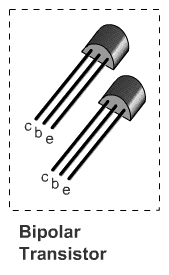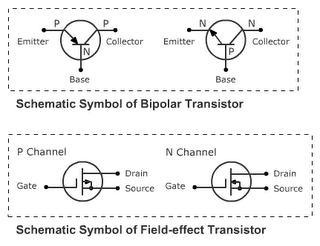Transistor
Basic Electronics Part 2 – Active ComponentsTransistors are the most commonly used electronic component. This is because the transistor is very flexible and can perform different functions. It can serve as a switch, an amplifier, or an inverter. Also, combining two or more transistors can produce different effects as with the logic Integrated Circuits (IC). Transistors can be classified into two; bipolar transistors and field-effect transistors (FET).

Bipolar Transistors
Bipolar transistors are transistors having two junctions. It could be a PNP or an NPN transistor. In operation, the first electrode supplies free charges, either protons or electrons, to be collected by the third electrode at the opposite end, through the middle electrode. The middle electrode controls the current. The first electrode is called the emitter, the second electrode is called the base, and the third electrode is the collector. It must be remembered that the collector and the emitter always has the same type of electrode that is different to that of the base. For example, in a PNP transistor, the base is composed of N-type (negative) material, and the collector together with the emitter is composed of P-type (positive) material.
Emitter – This is the terminal of the bipolar transistor that supplies free charges.
Base – This is the terminal of the transistor that controls the flow of current
Collector – This is the terminal whose function is to collect the charges supplied by the emitter.
Field-effect Transistors (FET)
Field-effect transistors function mostly in the same ways as bipolar transistors but they have a different composition. Unlike bipolar transistors, FET’s has a very high input resistance, typically on the range of megaohms, making it capable to take in higher voltage as input signal. The FET operation depends on controlling current through a semiconductor channel which is either N (negative) or P (positive). One side of the channel is the source electrode and the other end is the drain electrode. Current flows from the source to the drain. The voltage applied to the gate electrode controls the current to the channel. An FET is a unipolar device since the charge carriers in the channel have only one polarity.
Source – This is the terminal where the charge carriers enter the channel bar to provide current through the channel. The source corresponds to the emitter in bipolar transistors.
Drain – This is the terminal where current leaves the channel. The drain corresponds to the collector in bipolar transistors.
Gate – This electrode controls the conductance of the channel between the source and the drain. Input signal voltage is generally applied to the gate. The gate is the equivalent of the base in bipolar transistors.
Previous | Next


0 Comments:
Post a Comment
<< back to Home